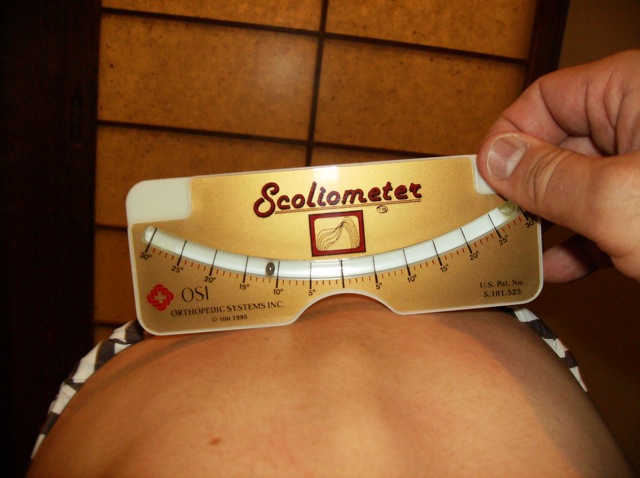How does a child diagnosed with scoliosis during a school screening end up with a 71º scoliosis by the end of the school year? That was the predicament that one of our NY patients, and her parents, found themselves in. The answer, unfortunately, is a scoliosis screening where the adults doing the screening didn’t convey the risks of a 7º scoliosis rotation.
When our patient’s dad, a medical professional, initially called he told us that he and his wife had never noticed anything terribly off with their daughter’s posture. After the screening, her parents were informed that she had some scoliosis rotation and were instructed to watch and wait. Somewhere in the messaging ‘watch and wait’ became the course of action – or inaction! Regular readers know that ‘watch and wait’ is a ‘burr under my saddle’ (a term courtesy of an online thesaurus). No one with a curve – of any significance – improves during ‘watch and wait’. When scoliosis is diagnosed as severe this can leave parents feeling perpetually perplexed! However, parents shouldn’t beat themselves up since it can take a discerning and experienced eye to detect scoliosis visually, especially when scoliosis is mild, or a double curve.
Upon getting this dad’s phone call, before seeing any films, we assumed our future patient probably had two balanced curves which can ‘hide’ the scoliosis (it’s the reason why we aim for more balanced curves at the end of bracing– the result is an improved postural appearance). In reality, in this case, it wasn’t the case.
Scoliosis became a sudden concern only after this girl was referred for x-rays which showed a 71º scoliosis curve. We share these stories, not to scare, but to make you AWARE. Fortunately, this scenario doesn’t play out often, but it does happen.
Here’s part of the equation about what happened in this girl’s case: schools and/or medical professionals assess for scoliosis using the Scoliometer™. The Scoliometer™ measures the angle of trunk rotation (ATR). It is a wonderful tool – the vast majority of the time – in the right hands, by people with training, and good judgment who are not concerned with cost containment. Over the years, the Scoliometer™ has allowed for scoliosis detection during spinal screenings in countless children. Since scoliosis is a three-dimensional condition, angle of rotation (ATR) is important when assessing scoliosis and gaining a baseline regarding spinal rotation prior to treatment.

Scoliometer™ is also another way to gauge patient improvement after participation in our scoliosis-specific program. The girl in this case experienced a 2º reduction in her scoliosis rotation the week she did our program. The Scoliometer™ reading helps us prevent unneeded X-rays. A reduction in scoliometer measurement can indicate that scoliosis is improving or perhaps, not progressing. As with any diagnostic tool, much depends on the expertise and judgment of the person measuring. There are instances where large magnitude curves remain undiscovered, are downplayed, or concerns regarding the existence of scoliosis are tabled based on the Scoliometer™ reading, as in this case.
Different scoliosis professionals use different scoliometer readings as their guide when ordering X-rays for scoliosis. In the past, 5º was the baseline to refer for an X-ray, but more often than not, it is now 7º. False negatives have occurred, meaning that the Scoliometer™ reading (scoliosis rotation) is low even though the actual Cobb angle is moderate or severe. When this happens it’s a missed opportunity for the earliest diagnosis possible. Depending on the philosophy/guidelines the professionals involved use, recommendations about how to proceed are according to the individual, or entity, involved in the screening/diagnosis.
On multiple occasions, we’ve seen circumstances like this where the patient ends up having an extremely severe scoliosis. These patients are usually the exception, not the rule, but let’s face it, the reality of scoliosis treatment in America today is that most patients with high magnitude curves (50º and over) whose parents seek out and comply with traditional medical advice are typically placed onto a gurney and wheeled into surgery.
The point: when scoliosis is initially suspected, get an X-ray right away to determine a baseline Cobb angle. It’s the best way to move forward and help with the decision-making process. Factor in Risser sign, the appearance of the sagittal plane, and for girls – the absence of, or onset date of menses, into the equation. These factors can help determine the best meaningful action steps.
It only makes sense that we can help kids with Cobb angles of 20º, 25º, or 30º more easily (for everyone involved) compared to kids with Cobb angles of 50º, 60º, or 70º. Helping kids soon after scoliosis is first detected can be far more impactful in terms of outcome. Also, programs for mild scoliosis or mildly moderate scoliosis often take less time, require fewer daily action steps, and are less involved for the patient (and their parents). Clinicallym at Scoliosis 3DC® our results have been consistently excellent patients with mild and mildly moderate curves.
There really is no excuse for the ‘watch and wait’ philosophy. Worrying about minimizing X-ray exposure to determine Cobb angle is insignificant in comparison to having concrete information about scoliosis for the decision-making process. This gives parents the prerogative to take meaningful steps to attempt to stop progression, or to potentially reduce scoliosis in a juvenile or an adolescent. Any doctor who tells you there’s nothing to do for scoliosis but bracing or surgery is ill-informed or closed-minded. Unfortunately, these beliefs are widespread and we continue to post to educate parents otherwise.
For more on Scoliometer™and rotation, read Evaluating Scoliosis – Scoliometer™ or Cobb Angle and Scoliometer™.

